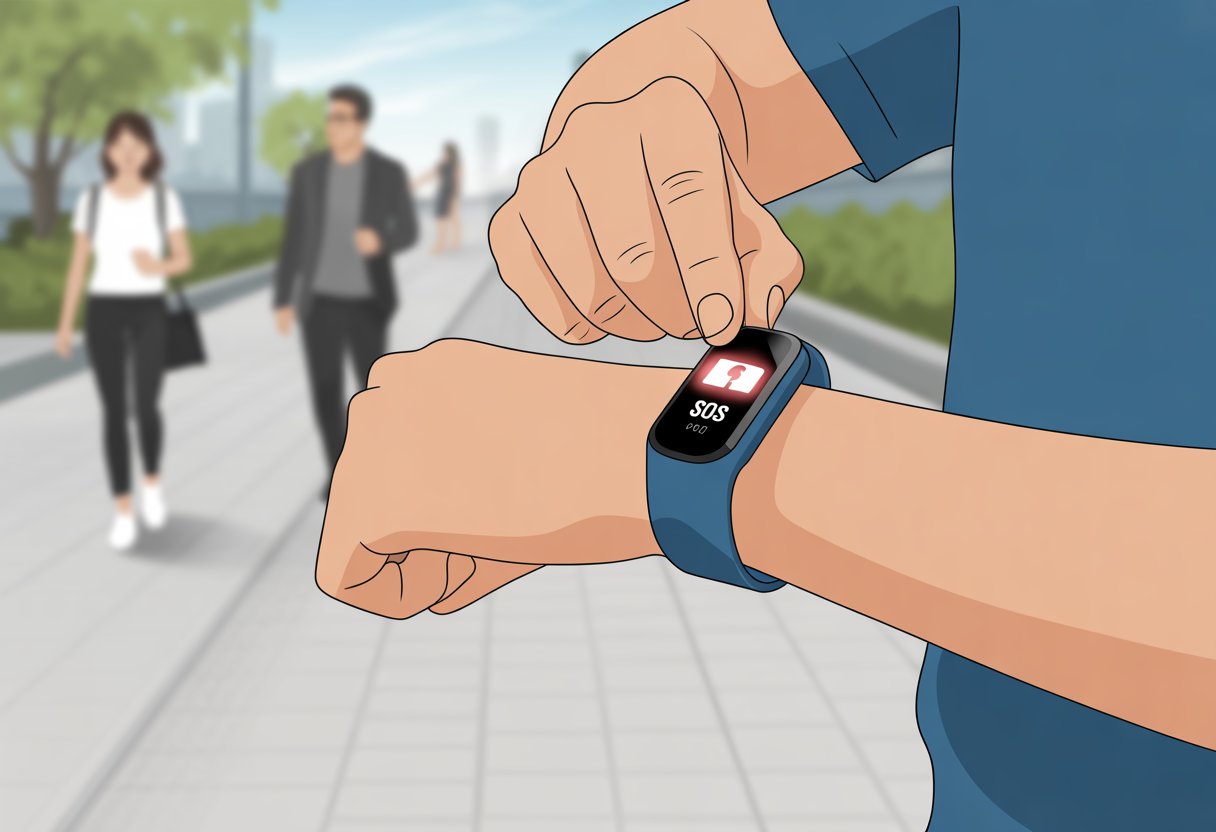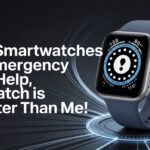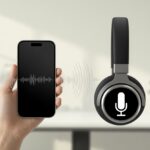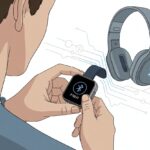Let’s be real—most of us buy a fitness tracker to count steps, not to plot our great escape. Still, these little wrist gadgets can do a lot more than just buzz us to get moving. Loads of fitness trackers now offer emergency SOS features, letting us call for help even if our phone’s lost somewhere in our gym bag. That’s not just about being fit—it’s about being prepared.

Ever wondered how to actually use those “secret agent” features? You’re not alone. Whether we’re holding down a button or tapping frantically, we can use our fitness tracker’s emergency SOS to get help if things go sideways.
It means we can head out for a run and not worry so much about getting stuck somewhere with only our smartwatch for company.
Understanding Emergency SOS on Fitness Trackers
Nobody wants emergencies, but life sometimes throws us a curveball—like tripping over our own shoelace in the dark. Fitness trackers are getting smarter, and now they help us call for help with just a quick press.
These features have turned our wearables into more than step counters.
What Is Emergency SOS?
Emergency SOS comes built into a lot of fitness trackers and smartwatches now. If we activate it, our device quickly sends alerts and our location to emergency services or someone we trust.
Usually, we just need to press and hold the right button (often the home or side button) for a few seconds. The tracker then connects us to help, even if our phone’s nowhere nearby.
It’s kind of like having a mini lifeguard on our wrist—minus the tiny float.
Most Emergency SOS systems keep things simple. With just a few taps or a long press, we can get help without scrolling through endless menus.
That’s a relief when things get chaotic.
How Fitness Trackers Enable Emergency Assistance
Not all trackers are the same, but the big names—Apple, Samsung, Garmin, Fitbit—have made SOS calls pretty reliable. For example, on Apple Watch, holding the side button brings up the Emergency Call slider (more here).
Some Samsung watches send SOS messages, including our location, if we press the home key three times (details here).
Many trackers automatically alert our chosen contacts or emergency services, sometimes with a loud sound. The built-in GPS shares our real-time location.
With all this, our fitness trackers do more than count steps—they act like little bodyguards when we’re out running, hiking, or just, well, living.
Key SOS Features to Look For
When we’re picking a wearable for emergency SOS, we should check for a few key things:
- Fast Activation: Can we trigger SOS quickly with a long press or triple tap?
- Automatic Location Sharing: Does it send our location right away?
- Custom Emergency Contacts: Can we choose who gets notified—family, friends, or that neighbor who always knows what’s up?
- Works Without Phone: Will it work if we leave our phone at home?
- Clear Alerts: Does it make it obvious that help’s been called?
Every brand does things a bit differently, so it pays to compare. Guides like this smartwatch SOS feature rundown can help narrow it down.
A good fitness tracker can turn “I’ve fallen and I can’t get up” into “Help’s on the way—and I know my heart rate, too.”
Setting Up Emergency SOS
Getting our tracker ready for emergencies takes a bit of prep. We need to add emergency contacts, make sure it can share our GPS location, and set up those automated texts.
It’s basically prepping our digital lifeline, just in case our epic dance moves go wrong.
Adding Emergency Contacts
We all know someone who never answers their phone. Let’s not pick them as our emergency contact.
Instead, we should choose people who’ll actually pick up if things go south. Most trackers let us add several contacts, usually in the device’s app under Emergency or SOS settings.
We open the app, find the option to add emergency contacts, and pick names from our list. Double-check those numbers—one typo and we’re texting Larry the pizza guy instead of help.
Some devices let us label contacts as “emergency,” which makes things easier if disaster (or clumsiness) strikes.
Here’s a quick rundown:
- Open the device’s app on our phone.
- Go to Settings > Emergency or SOS.
- Tap Add Emergency Contact.
- Pick people who’ll actually help, not just laugh and hang up.
Once we’ve set it up, our tracker knows who to alert when we need it.
Enabling Location Services
We want rescuers to find us, not send a “Where are you?” text. That’s where GPS comes in.
Sharing our location helps emergency services or friends get to us faster. For most trackers, we just turn on location sharing in the app’s Location or Permission settings.
Some trackers ask for Location Access All the Time. If that makes us nervous, remember it only kicks in during SOS. A quick toggle in settings and we’re set.
Samsung and Apple let the tracker send our real-time position during SOS events. More info on using location with Samsung is at their support page.
Want extra safety? We set the location update interval to frequent—no one wants to be found based on last week’s GPS ping.
Configuring Automated Text Messages
Automated texts are like having a robot sidekick who’s ready to alert help with one tap. Our tracker can send a custom message to our contacts, letting them know what’s up and where we are.
In the settings, look for SOS Message or Automated Alert.
We should keep the message clear and simple (zombie jokes optional). Something like: “This is an emergency. I need help. My location: [automatic GPS].” The tracker fills in the GPS part when it sends the alert.
Most trackers let us preview or tweak the message before saving. Let’s keep it serious enough to be useful, and short enough so friends don’t think it’s a prank.
After setting it up, we can run a test if our device allows—just to make sure our contacts actually get the message and can read our location. Apple’s steps for Emergency SOS text setup are here.
Activating Emergency SOS During a Crisis
If we ever get into trouble, our fitness tracker’s Emergency SOS can really save the day. It’s not just for counting steps—it can call for help, share our GPS, and even detect if we’ve taken a nasty fall.
How to Trigger the SOS Feature
No one wants to fumble in a crisis. On most trackers, activating SOS is pretty straightforward:
- On Apple Watch, we press and hold the side button until the Emergency Call slider pops up, then slide it or keep holding to start the call. More details in Apple’s official guide.
- For Samsung Galaxy Watches, pressing the top-right Home button five times quickly gets us to emergency help. Steps vary a little by model, but they’re similar—see Samsung’s SOS feature.
- Other brands usually have a way to press or hold a button, but it’s best if we practice first. Last thing we want is to mash buttons like we’re playing Mario Kart.
Pro tip: Set up SOS in the watch’s settings before we need it. Otherwise, we’ll just be pressing buttons and hoping—never a solid plan.
Steps for Immediate Emergency Assistance
When we trigger SOS, our tracker usually does a few things right away:
- Calls emergency services in our area.
- Sends a text or alert to our contacts with our location.
- Starts a loud alarm—so we can feel like we’re in a spy movie.
Some devices keep us connected to emergency operators during the call. Many trackers have incident detection—if we take a hard fall, the watch checks if we’re okay and calls for help if we don’t respond.
Let’s keep our contacts up to date in the app. Otherwise, our long-lost cousin might get the alert instead of someone who can actually help.
Communicating Your GPS Location
When we activate SOS, most trackers send our GPS location to emergency services and our contacts.
That way, friends and responders know exactly where we are—even if we can’t talk. Some watches update the location in real time, so help can find us if we’re moving (or just pacing nervously).
We can check or adjust which contacts get our location in the watch or phone’s health app. Some devices even show our live GPS coordinates on the screen, in case we need to shout them out.
Just a heads up: if our watch doesn’t have cellular or isn’t paired with a phone, SOS and GPS sharing might not work as well. Let’s check everything’s connected before our next adventure—unless we’re feeling extra daring.
Device Compatibility and Network Requirements
If we want our fitness tracker to call for help like a true secret agent, we need the right tech and a solid connection. These gadgets may look cool, but they’re picky about which phones they work with and whether the network’s behaving.
Compatible Smartphones and Operating Systems
Not every fitness tracker gets along with every smartphone. The Apple Watch, for example, insists on an iPhone. Samsung’s Galaxy Watch plays nice with Android and, to a point, iOS, but it still has its quirks.
Throw software updates into the mix and things get even messier. Apple Watches demand iOS 12 or newer. Google Pixel Watches stick to their Pixel crowd.
Thinking about a Garmin? You’ll need the Garmin Connect app. It works for both iPhones and Android devices—unless your phone is ancient.
Here’s a quick compatibility check:
| Device | Compatible With | Special Requirements |
|---|---|---|
| Apple Watch | iPhone only | iOS 12 or later |
| Galaxy Watch | Android, some iOS | Recent OS, Galaxy Wearable app |
| Garmin | iPhone, Android | Garmin Connect app |
| Google Pixel Watch | Pixel, some Android | Pixel Watch app |
Oh, and don’t forget—if you don’t have the latest apps and updates, your heroic SOS plan might just fall flat.
Data Plan and Network Coverage Essentials
A fitness tracker might make us feel unstoppable, but if our smartwatch can’t grab a signal or has no data plan, its SOS button is basically just a fancy decoration.
Cellular versions like the Apple Watch with LTE can call for help all by themselves. Others rely on our smartphone to send out the SOS.
We have to check that our data plan is active and not stuck in some forgotten budget plan from a decade ago.
Out in the wild? Even the best tech needs a working cellular or Wi-Fi connection. Some Garmin models let us share our location, but most still lean on the phone’s connection through the Garmin Connect app.
If our phone dies, loses signal, or runs out of data, our fitness tracker is probably just counting steps while we wait for a rescue pigeon.
Maximizing Battery Life in Emergency Situations
No one wants their fitness tracker to die during an emergency. We need to squeeze every last bit of battery life, RAM, and ROM so our device sticks with us until help shows up.
Battery-Saving Tips
Let’s be real—fitness trackers love to show off with bright screens. But during an emergency, we need them to chill out.
Lowering the screen brightness as much as possible keeps things running longer. Dropping it to zero (if we can still see anything) can save a surprising amount of power, based on tips about maximizing watch battery life.
Turning off extra features—Wi-Fi, Bluetooth, heartbeat animations—can give us more time. GPS drains batteries fast, so we only use it when necessary.
If our device has a battery-saving mode, we should turn it on right away.
We also need to check which apps are eating up the most RAM or ROM. Closing memory-hogging apps keeps things running smoother, so the SOS function gets top priority.
Optimizing Features for Longer Use
Fine-tuning features gives our tracker a fighting chance. Reducing how often it checks GPS—every few hours instead of minutes—can add days to battery life, as some hikers found on long tracking trips.
Turning off fitness tracking and reminders for now isn’t a bad idea. Every buzz or pop-up notification takes a bite out of our battery.
If we can choose which notifications we get, it’s time to be picky. Emergency alerts only.
Updating to the latest firmware sometimes helps with battery and resource management. Before any big trip, we should update our tracker to get the newest power-saving tricks.
Ensuring Privacy and Safety
Using a fitness tracker with SOS features means we want help fast, but we also want our info to stay private. It’s not just about being prepared—it’s about being smart with our data.
Managing Data Sharing Settings
Some fitness trackers want to share everything, like an overexcited puppy. Luckily, we can control that.
It’s smart to check what data our device shares by digging into its settings. Most trackers let us pick who can see our activity, health stats, and location.
Turning off automatic sharing with social media—or that one competitive pal—is a good move.
Review what your emergency contacts will see if SOS is triggered. Some trackers send real-time location or a medical profile when help is needed.
That’s useful, but we don’t want our dog-walking route broadcast everywhere. Double-check so only the right people get the info.
Quick Tips:
- Go to device settings > privacy or sharing.
- Select “Share only with emergency contacts.”
- Turn off connections to third-party apps you don’t trust.
Protecting Personal Information
Let’s keep our step count (and everything else) private. Start with strong passwords for any accounts linked to the tracker.
That keeps out hackers who might want more than just our steps.
Make sure the device is updated. Updates fix security bugs—think of it as bug spray for data thieves.
If the tracker offers a lock screen or PIN, set it up. Losing a device isn’t funny if someone gets our private info.
Checklist for privacy:
- Use a unique password for the tracker app.
- Turn on two-factor authentication if possible.
- Avoid public WiFi when sharing health details.
- Review privacy settings in the app and on the device regularly.
This way, we can focus on fitness and SOS alerts—without worrying about privacy leaks.
Integrating Fitness Tracking With Emergency SOS
Mixing fitness tracking with SOS isn’t just about burning calories—it’s adding a safety net. These gadgets now do more than count steps; they look out for us, sometimes a bit too much.
Using Heart Rate Monitor and Incident Detection
Our heart rate monitor isn’t just for humblebrags at the gym. It’s also a safety feature.
If our heart rate spikes—or drops too low—the tracker can send an alert.
Incident detection makes things even safer. If we crash our bike or trip over a dumbbell, the watch tries to get our attention.
If we don’t move or respond, it can trigger a call for help. Devices like Apple Watch combine fall detection with SOS features.
Tracking Outdoor Activities and Safety
Tracking outdoor activities helps us stay safer on trails, roads, or even those weird neighborhood sidewalks.
When we start a workout, the tracker logs our path, pace, and distance.
If we vanish or our hike turns into a survival story, our last known location helps rescuers.
Some trackers let us send live location details to a friend or family member. If we wander where we shouldn’t, someone knows.
This is handy for running, cycling, or hiking—especially if we tend to get lost. For more on mixing outdoor tracking and safety, check out this guide to smartwatches with SOS features.
Staying Prepared During Workouts
Workouts are great until we forget water—or emergency contacts.
Before starting, we should set up emergency contacts and make sure fall detection and SOS features are on. It’s like checking for snacks before a movie, just way more important.
Keeping our device’s system up to date gives us the latest safety tweaks. And hey, let’s check if the pedometer is counting steps right—panic-sprinting from a bee should count, too.
Notable Brands and Innovations in SOS-Enabled Trackers
We want our wearables to do more than count steps. SOS-enabled trackers offer peace of mind, and some brands really stand out with clever features and fast emergency response.
Apple Watch Series 4 and Emergency SOS
Honestly, most of us don’t expect our watch to be a mini lifeguard, but the Apple Watch Series 4 is close.
With Emergency SOS, if we’re in trouble, we just press and hold the side button. The watch calls emergency services and sends our location to contacts—sometimes faster than we can yell, “Help!”
We don’t even need our phone if the watch has cellular service. If we fall and don’t respond, Series 4’s fall detection can alert help automatically.
It’s like a personal bodyguard on our wrist—one that cares about our health, not our pizza habits. Apple leads the way with user-friendly emergency SOS features that can save lives, even if we just wanted to check the time.
Garmin’s Safety Features Overview
If marathons are more our thing, the Garmin lineup is packed with SOS tools for thrill seekers.
Most modern Garmin watches offer incident detection and assistance features. If we tumble while running or cycling, the watch can notify our emergency contacts through the Garmin Connect app.
The app acts like Mission Control—less rockets, more sweaty stats. We set up emergency contacts, and the app handles alerts when things go wrong.
LiveTrack lets us share our location with friends or family, so someone always knows where we are (sorry, privacy). It’s a trusty sidekick, minus the fur.
Comparing Leading Wearable Devices
Picking between these SOS-enabled wearables feels a bit like choosing a pizza topping—good options everywhere.
The Apple Watch Series 4 stands out for simple emergency calling and automated fall detection that works even without our phone.
Garmin devices win points for integrating with the Connect app, giving us hands-off safety tools for intense activities.
Samsung and some third-party trackers are catching up, with emergency features like auto-alert messaging and fall alerts.
Here’s a quick side-by-side:
| Brand | Emergency SOS | Fall Detection | App Integration |
|---|---|---|---|
| Apple Watch S4 | Yes | Yes | Apple Health, iPhone |
| Garmin | Yes | Yes | Garmin Connect |
| Samsung | Yes | Yes | Samsung Health |
So, whether we’re running, hiking, or just want backup in case we trip over a shoelace, these innovations help us feel a bit safer (and maybe a bit more heroic).
Maintaining an Active Lifestyle With Peace of Mind
We all want to stay active, get healthy, and feel safe—even if our fitness tracker sometimes mistakes our wild dance moves for a “fall.”
Mixing safety features like SOS with fitness tracking helps us move more and stress less.
Using SOS While Tracking Health Metrics
Fitness trackers act like our tiny coaches, cheering us on as we log steps, burn calories, and track our legendary sleep patterns.
Even if they claim we only dream in “light sleep,” we keep wearing them. But honestly, the SOS function might be the real game-changer.
If you take a tumble or need help, most newer trackers have SOS features built right in. With just a couple of taps, your watch can ping emergency contacts and send out your GPS location.
Some devices with fall detection will even do it on their own—no need to press anything. Gravity handles that part for you, whether you want it to or not.
Setting up emergency contacts is pretty simple in the settings menu. These safety features usually run alongside the health tracking, so your family not only knows if you’ve burned 400 calories dancing, but also if you accidentally breakdanced into the coffee table.
If you want to dig deeper, check out options like the SOS Smartwatch with fall detection.
Balancing Fitness and Emergency Awareness
Tracking every step, counting calories, checking our sleep stats—honestly, it’s kind of addictive. We get caught up in the numbers, but sometimes forget that these fitness trackers can actually help us out in a real emergency.
When we keep SOS active, we pick safety without losing out on the fun. We still blast our favorite playlists (Apple Music, anyone?), set up reminders for workouts, and watch our weight change—hopefully, that’s just muscle. And if something goes sideways, help’s just a tap away.
I like to check my emergency settings whenever I update my device’s OS. That way, my fitness goals and my backup plans are both up to date. Less stress, more peace of mind, and maybe a little extra motivation for the next dance break.
- Best Bluetooth Headphones for Airplane Travel: Drown Out Crying Babies in Style - December 8, 2025
- How to use Bluetooth headphones with an intercom system and Finally Escape Tangled Wires - December 7, 2025
- Best Fitness Trackers for Silent Alarms: Wake Up Without the Drama - December 7, 2025






